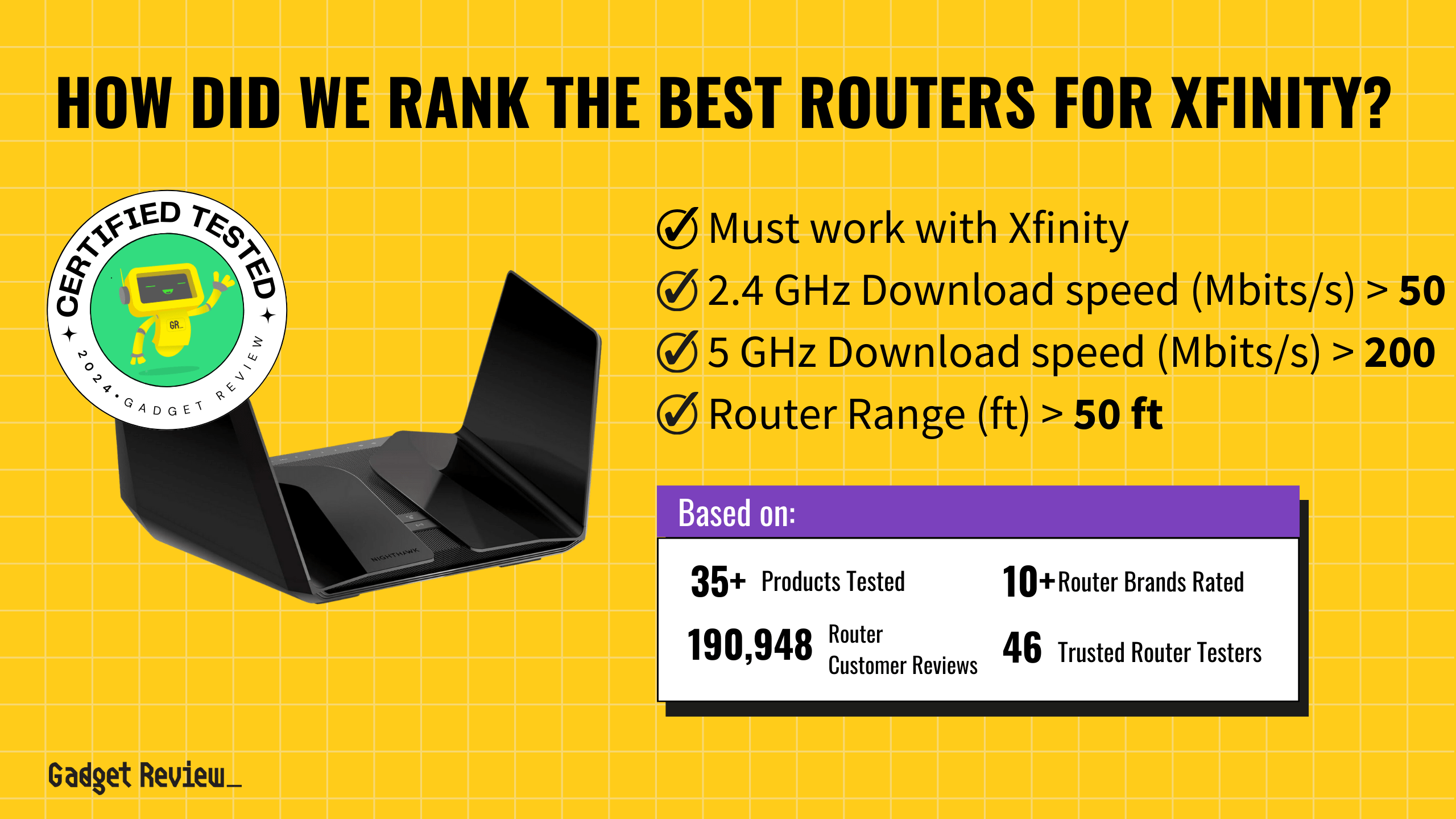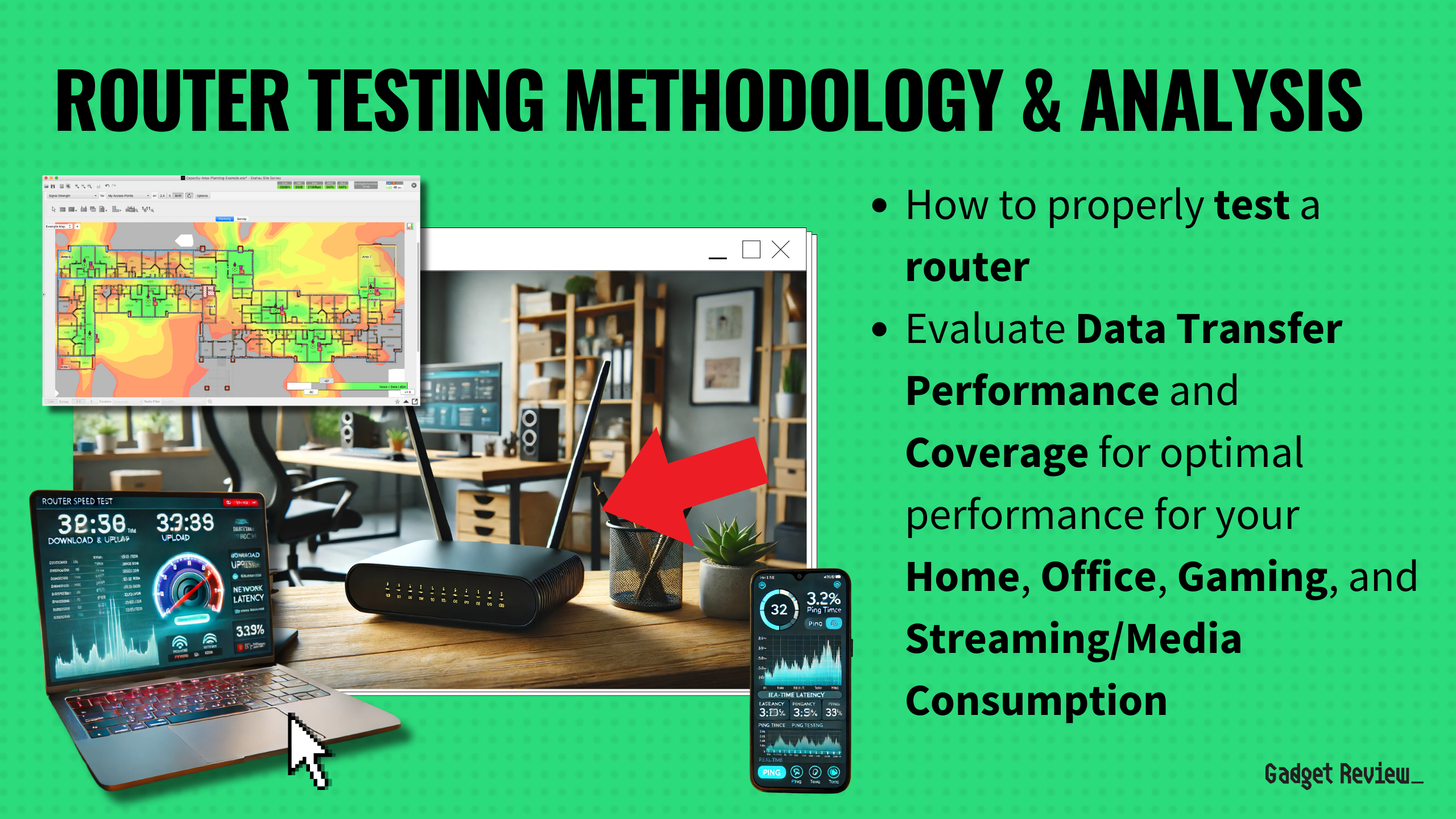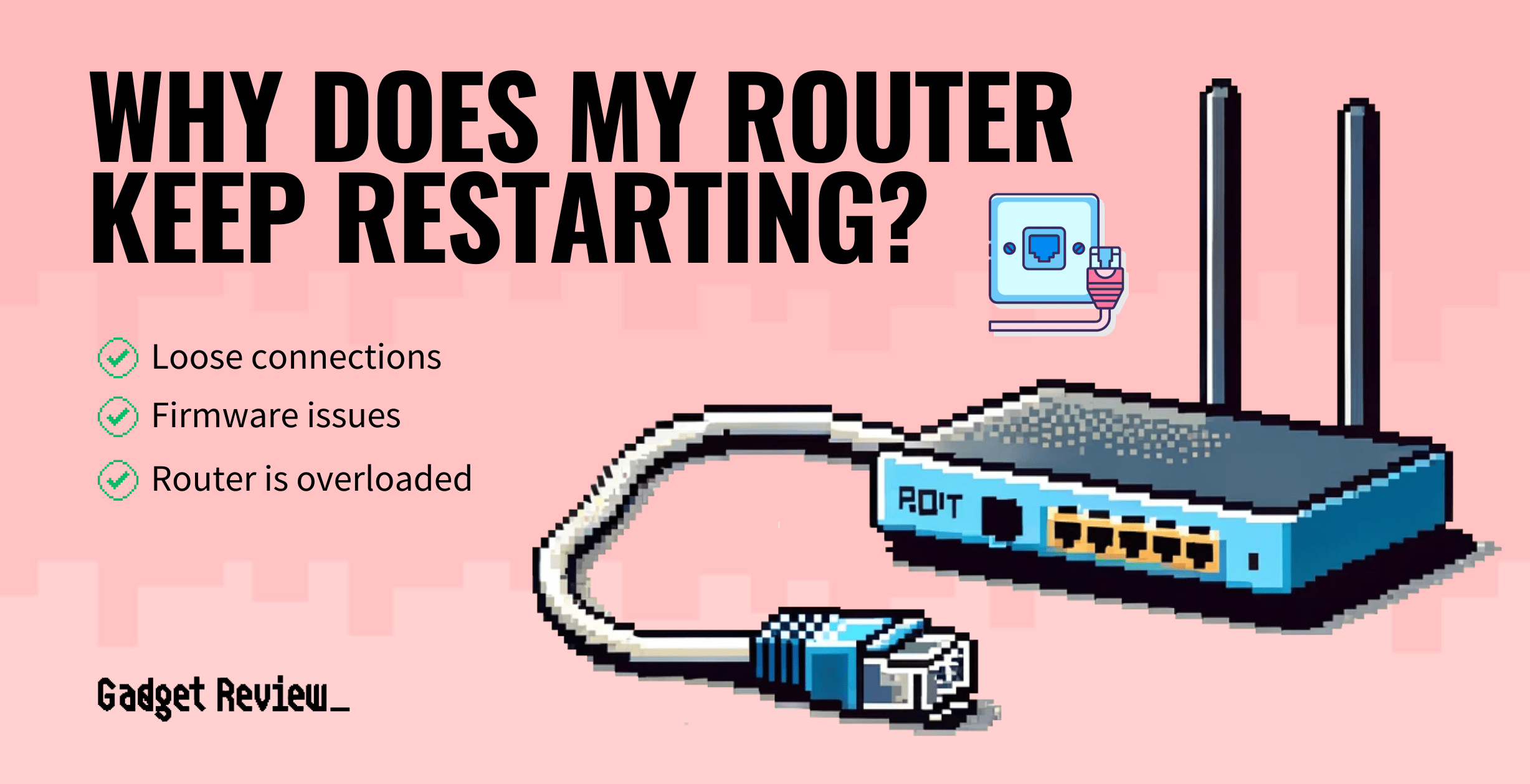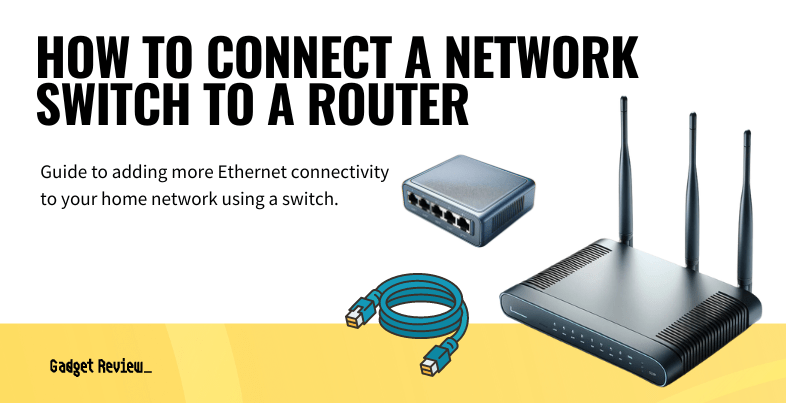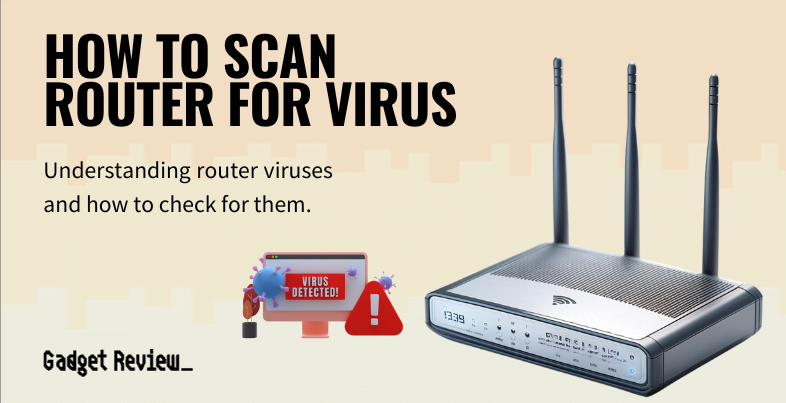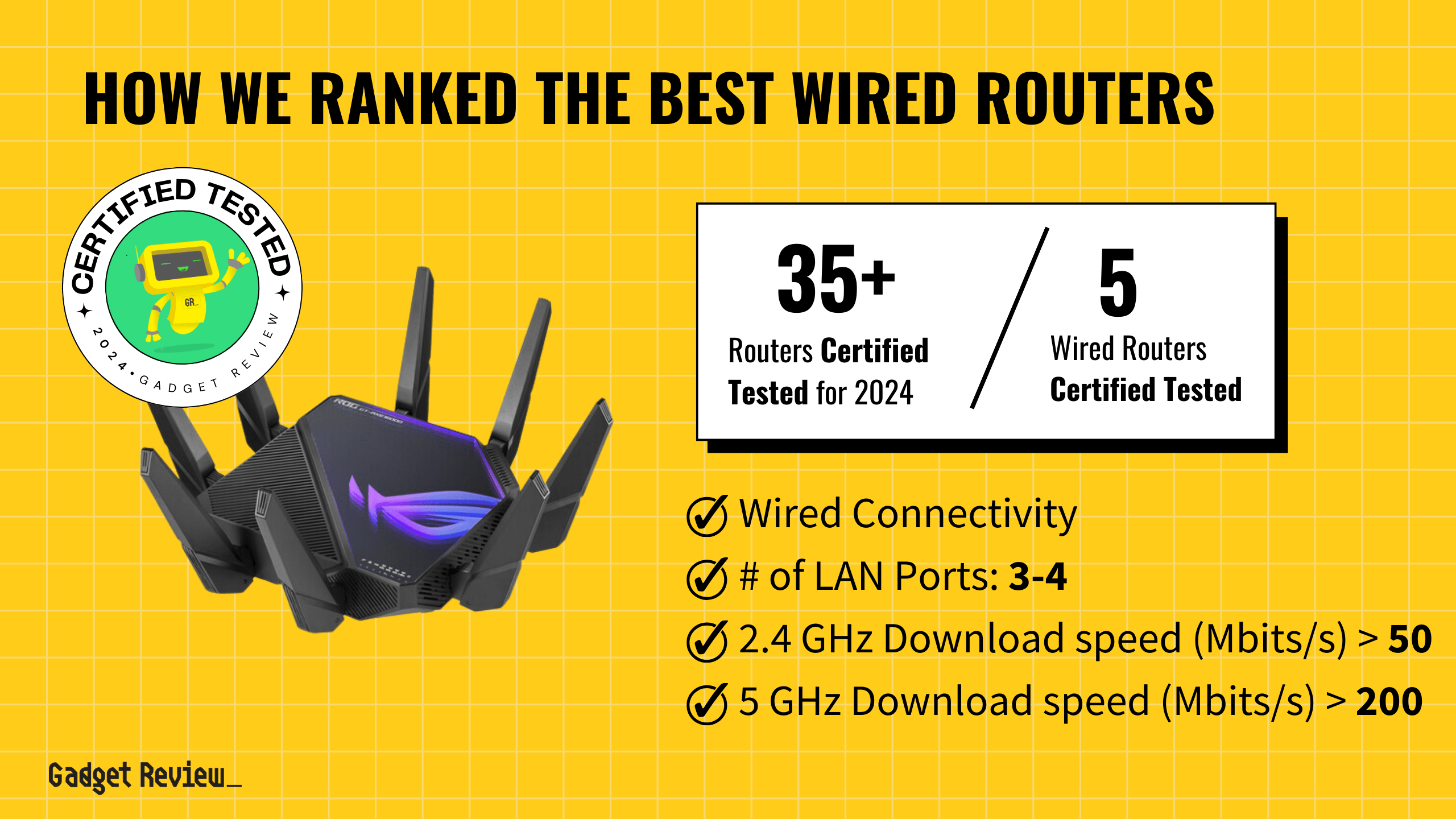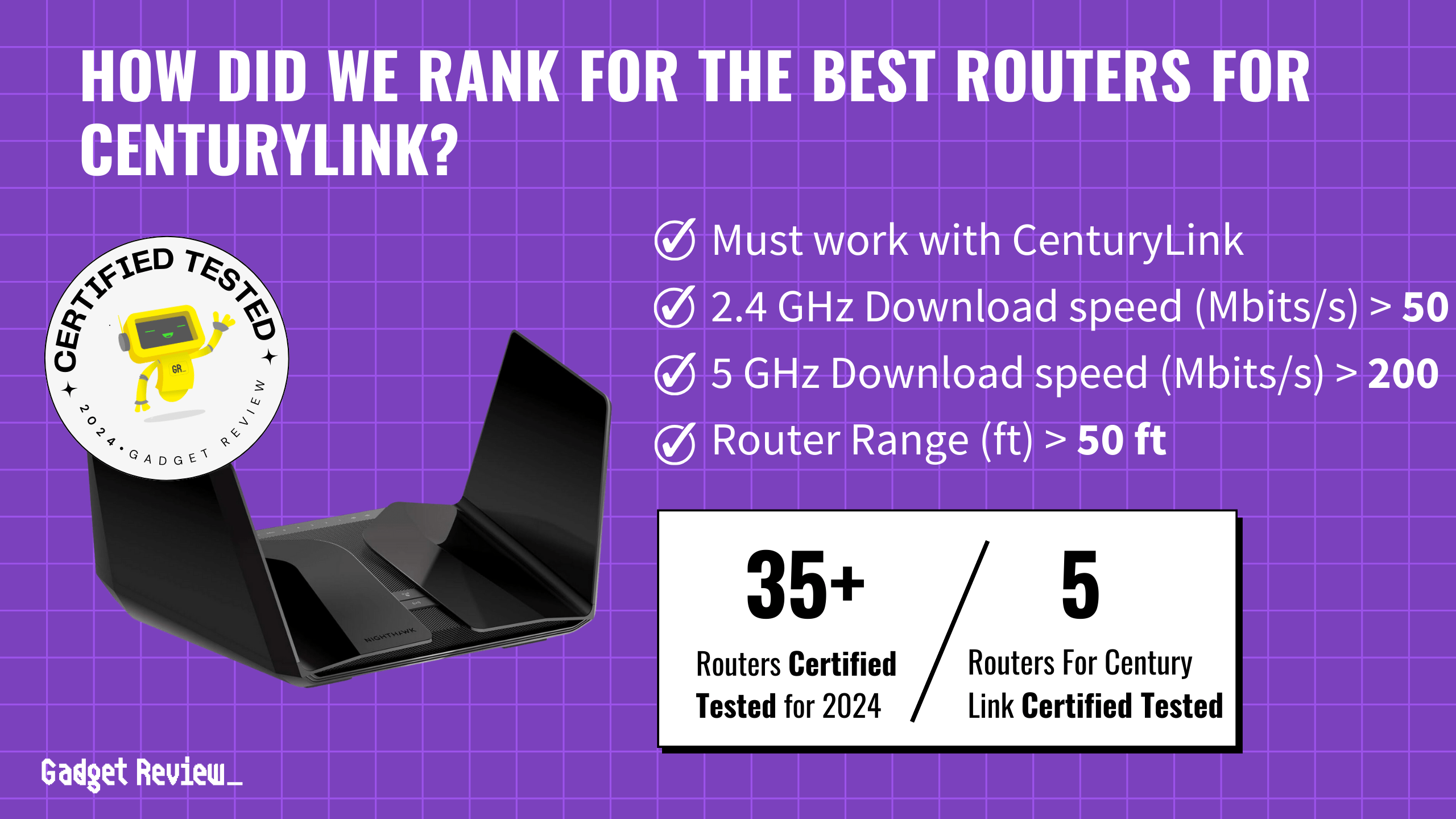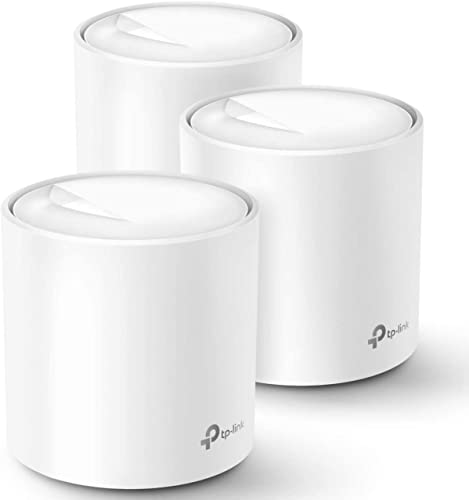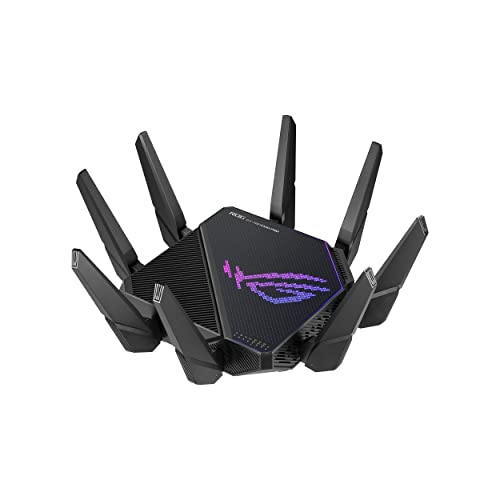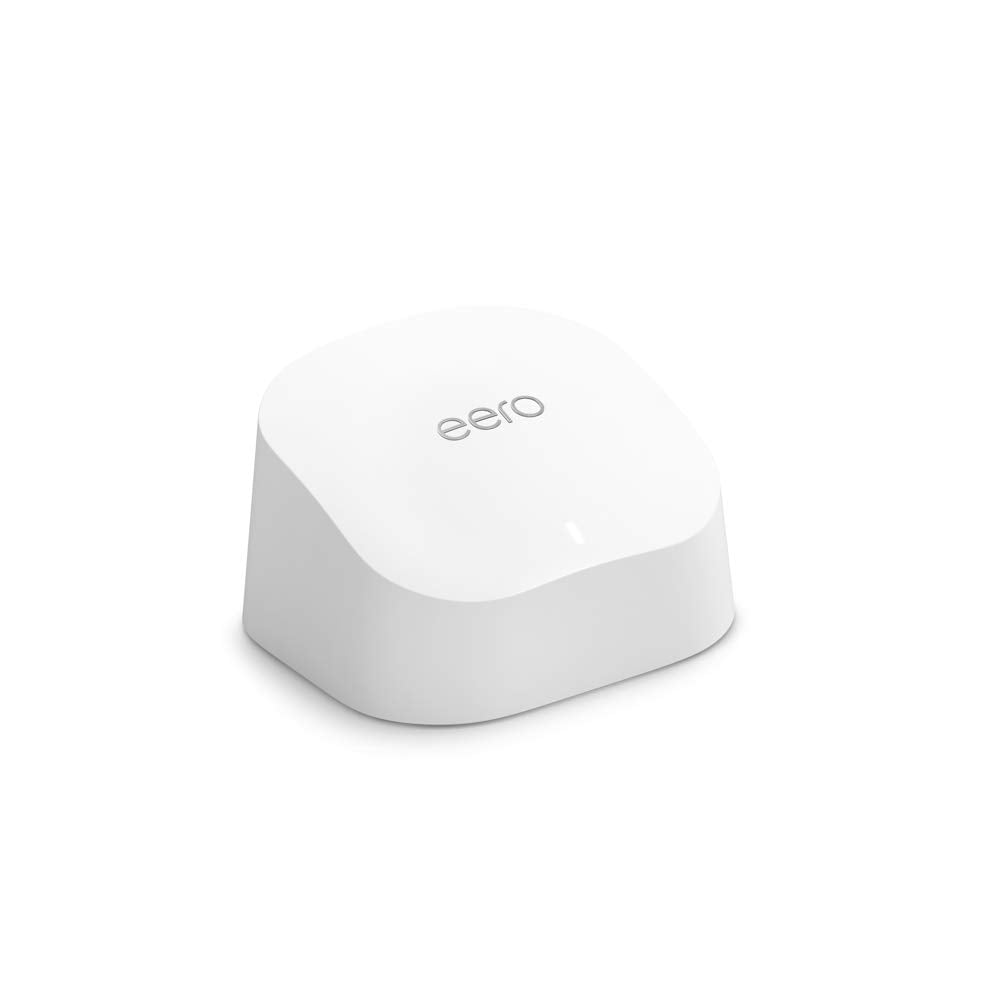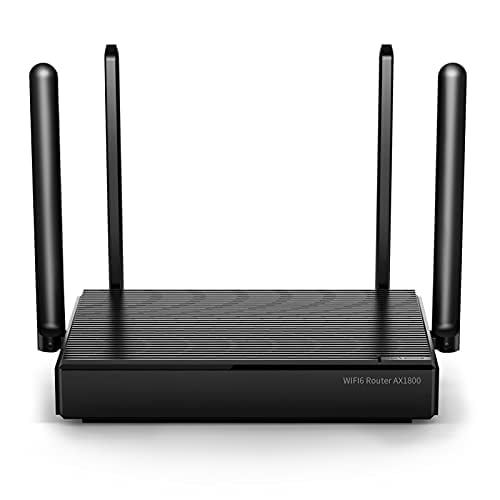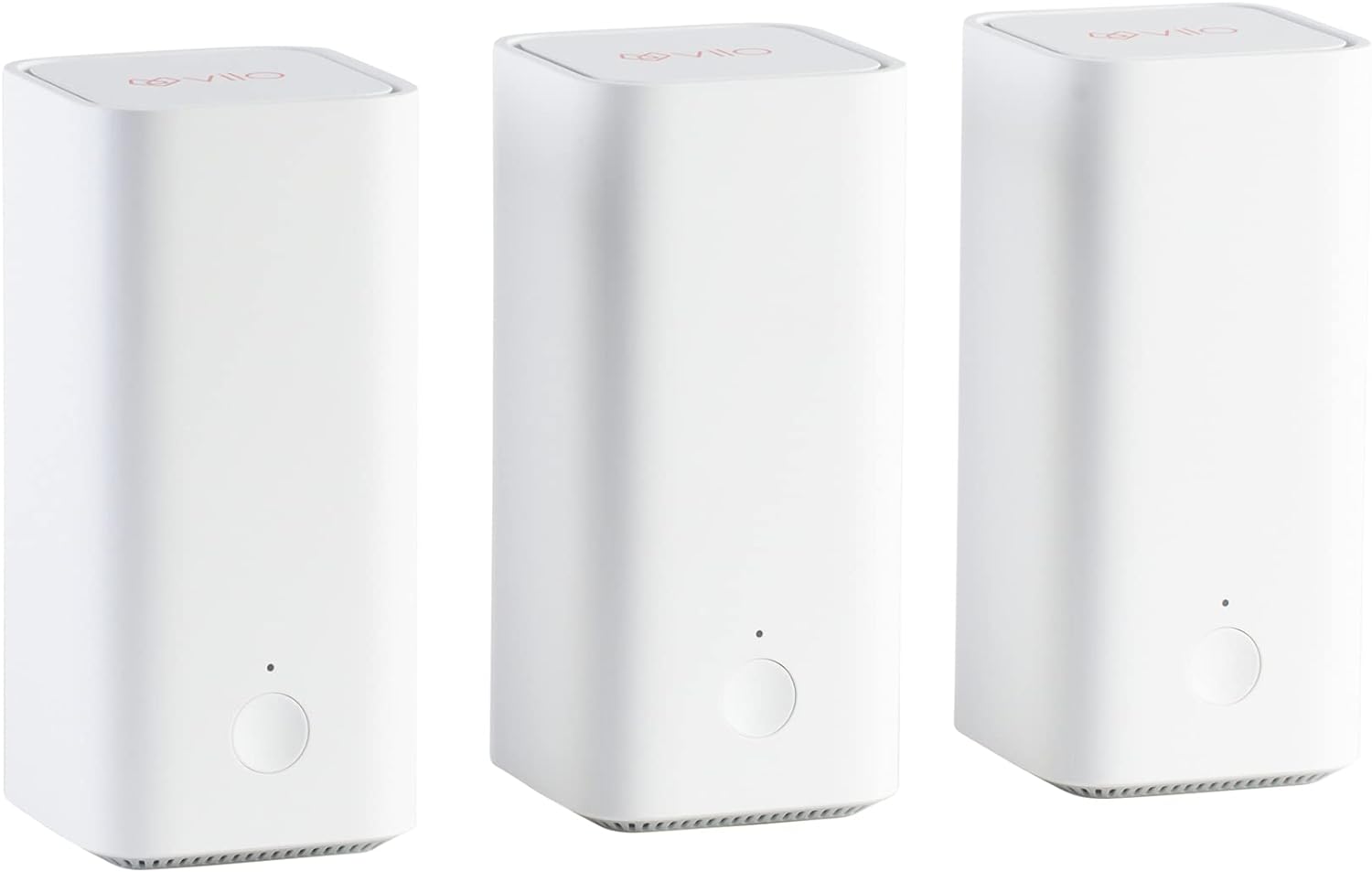When selecting the best routers for Xfinity, key factors include Wi-Fi speed, range, and ease of use. Look for routers that support a minimum of 50 Mbps on 2.4 GHz and 200 Mbps on 5 GHz, ensuring reliable connections for high-bandwidth activities like streaming and gaming. We evaluated 37 routers, analyzing 194,551 reviews to filter out unreliable feedback, and certified the testing of each product.
Our approach ensures accuracy by using our data-driven True Score, focusing on verified performance and excluding fake and low-quality reviews. Five routers stood out, demonstrating superior performance and reliability, making them excellent routers for Xfinity users.
How Did We Rank the Best Routers for Xfinity?
To create our buying guide for the best routers for Xfinity, we examined testing methods and customer reviews from over 200 sites. Our analysis distilled which criteria matter most for Xfinity routers. We identified 2 required test results, 2 nice-to-have features, and 1 must-have specification. By scrutinizing expert reviews and evaluating critical pain points, we ensure our recommendations meet the highest standards. Our true score system integrates all this data, providing you with the most accurate router rankings for Xfinity.
Our commitment to unbiased reviews is powered by our ‘True Score’ system, targeting low-quality and fake reviews. When you shop through our links, you’re backing our mission. Dive deeper to see how.
?️ Minimum Specifications
- Must work with Xfinity
? Test Criteria
- 2.4 GHz Download Speed: A download speed on the 2.4 GHz band of at least 50 Mbits.
- 5 GHz Download Speed: A download speed on the 5 GHz band of at least 200 Mbits.
? “Nice To Haves”
- Router Range: A range of at least 50 feet before the signal from the router begins to become noticeably weaker.
- Latency: A latency of 30 ms or less.
Latest Updates
- 06/19/2024: Republished the list to include the best routers for Xfinity based on our True Score system.
Top Routers for Xfinity For 2025
Prices accurate at the time of publishing

Best Overall

Runner Up

Best Value

Best Budget

Best Mid-Range

Premium Pick
Asus RT-AX86S
Best For Long Range
Asus RT-AX86S is fantastic for users in large homes, offering solid 5 GHz connectivity for heavy online activities.
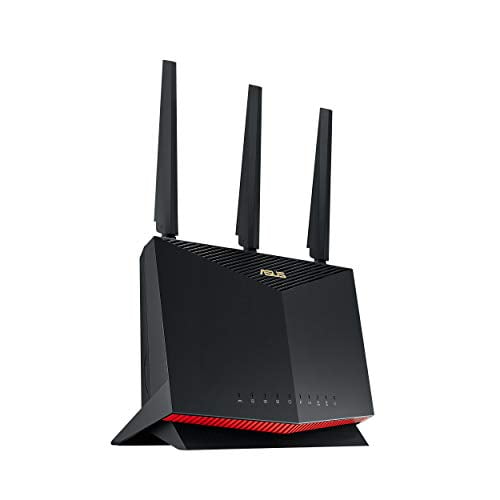
True Score
83833Experts
891kCustomers
Absolutely Fresh
 SAVE $150$249.99$99.99
SAVE $150$249.99$99.99Read More
Snapshot
Reasons to Buy
- Fast WiFi and download speeds
- Incredible range of coverage
- Easy installation and set up
- Low Latency
Reasons to Avoid
- Lacks Backhaul and Mesh Networking
Specifications

# of LAN Ports 4 
Frequency Bands 2.4 GHz, 5.0 GHz 
MU-MIMO Support Yes 
Wireless Standard AC, AX, N 
Mesh System No 
Quality of Service Prioritization Yes 
# of Phone Ports n/a 
# of WAN Ports 1 
App Compatible Yes 
Available Storage 256MB 
Band Technology Dual 
Data Encryption Type WPA, WPA-Enterprise, WPA2, WPA2-Enterprise, WPA3, WPA3-Enterprise, WPS 
Energy Star Certified No 
Integrated Modem No 
LAN Ports 4 Gb Ethernet 
Number of Antennas 4 
Parental Controls Yes 
Processor Cores Dual 
Processor Speed 1.8GHz 
WiFi Range 5400 sq. ft 
WiFi Speed 5.7 Gb 
Wired Speed – All Specs
Test Results
2.4 GHz Download speed (Mbits/s) 89 5 GHz Download speed (Mbits/s) 563 6 Ghz Download speed (Mbits/s) 0 Latency (ms) 15 Router Range (ft) 140 2.4 GHz Upload speed (Mbits/s) 0 5 GHz Upload speed (Mbits/s) 23 6 Ghz Upload speed (Mbits/s) 0 All Tests
All Retailers
- $99.99$250Save $150
- $202.24$225Save $23
Our Verdict
If you live or work in a large space and need reliable internet, the Asus RT-AX86S provides stable connectivity through its 5 GHz performance and range. Boasting download speeds of 563 Mbits/s and upload speeds of 23 Mbits/s on the 5 GHz band, it facilitates bandwidth-heavy tasks such as 4K video streaming, online gaming, and significant file transfers. The 2.4 GHz band, with download speeds of 89 Mbits/s, caters well to IoT devices and general web browsing. Though it doesn’t feature a 6 GHz band, its 5 GHz performance still supports digital-intensive lifestyles, offering a valuable option without breaking the bank.
This router’s Wi-Fi coverage reaches up to 140 feet, ensuring broad and reliable coverage suited for expansive areas. With a latency of 15 ms, the Asus RT-AX86S ensures swift response times, which is critical for lag-free gaming and smooth video conferencing.
When compared to the affordable TP-Link Archer AXE75, the Asus RT-AX86S provides a much greater range, making it the superior choice if you live in a larger living space. However, if minimizing delays is a priority, the TP-Link, with its superior latency, might be a better fit.
Despite its modest performance on the 2.4 GHz band, the Asus RT-AX86S’s exceptional 5 GHz speed and coverage make it a dependable option for gamers, streamers, and those looking to enhance their smart home systems. If you’re an Xfinity customer needing a blend of affordability, efficiency, and robust performance, this router ensures a seamless and high-performing home network.
Read Less

Best Overall

Runner Up

Best Value

Best Budget

Best Mid-Range

Premium Pick
Netgear Nighthawk RAXE300
Best For Vpn
Netgear Nighthawk RAXE300 is outstanding for Xfinity users who enjoy gaming and streaming. It offers fast speeds and low latency for a smooth online experience.
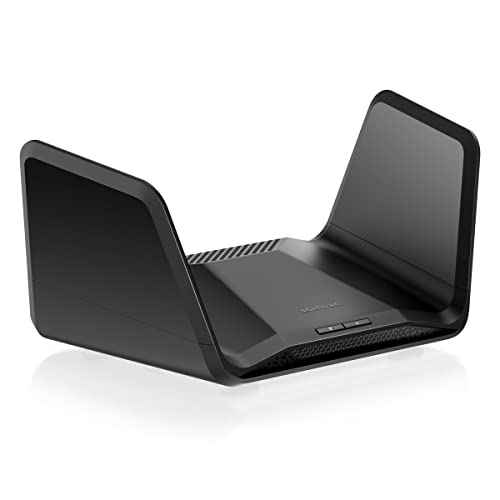
True Score
83829Experts
894kCustomers
Absolutely Fresh
 SAVE $135$299.99$164.99
SAVE $135$299.99$164.99Read More
Snapshot
Reasons to Buy
- Superb Wi-Fi speeds
- Wide range
- Simple setup
Reasons to Avoid
- Limited range (6GHz)
- No USB A port
- Subscription-based security solutions
Specifications

# of LAN Ports 6 
Frequency Bands 2.4 GHz, 5.0 GHz, 6.0 GHz 
MU-MIMO Support Yes 
Wireless Standard AC, AX, N 
Mesh System No 
Quality of Service Prioritization No 
# of Phone Ports 1 
# of WAN Ports 1 
App Compatible Yes 
Available Storage 256MB 
Band Technology Tri 
Data Encryption Type WPA-PSK, WPA2-PSK, WPA3 
Energy Star Certified No 
Integrated Modem No 
LAN Ports 4 Gb Ethernet 
Number of Antennas 6 
Parental Controls Yes 
Processor Cores Quad 
Processor Speed 1.7GHz 
WiFi Range 2500 sq.ft 
WiFi Speed 7.8 Gb 
Wired Speed 1000 Mb All Specs
Test Results
2.4 GHz Download speed (Mbits/s) 222 5 GHz Download speed (Mbits/s) 852 6 Ghz Download speed (Mbits/s) 757 Latency (ms) 5 Router Range (ft) 170 2.4 GHz Upload speed (Mbits/s) 0 5 GHz Upload speed (Mbits/s) 175 6 Ghz Upload speed (Mbits/s) 247 All Tests
All Retailers
- $164.99$300Save $135
- $239.97$400Save $160
- $299.99
- $379.99$399Save $19
Our Verdict
Xfinity customers who game or stream will appreciate the outstanding speed and responsiveness of the Netgear Nighthawk RAXE300. It offers download speeds of a best-in-class 221.65 Mbits/s on the 2.4 GHz band, 851.6 Mbits/s on the 5 GHz band, and 756.8 Mbits/s on the 6 GHz band. This means it’s suited for intense activities such as competitive gaming, high-definition 4K streaming, and virtual reality. Its upload speeds are equally impressive, with 175 Mbits/s on the 5 GHz band and 247.2 Mbits/s on the 6 GHz band, facilitating quick and effective data transfers for high-quality video calls, gaming, and online backups.
If you need minimal lag for seamless online activities, it has a superior latency of 5 ms and a range of 170 ft. These ensure that online activities remain uninterrupted in a large house or office. It’s also equipped with robust security features and supports the latest wireless standards (AC, AX, N), positioning it as a wise investment for future-proofing your home network.
While the Asus RT-AX86S may offer specialized features at a cheaper price, the Nighthawk RAXE300 boasts faster speeds and lower latency, making it an excellent fit for homes with several users who perform intense internet activities simultaneously.
Boasting high download and upload speeds across all bands, minimal latency, and significant range, the Nighthawk RAXE300 is an exceptional choice if you’re an Xfinity customer who games, streams, or runs a small business. Although it is more expensive than other routers, its comprehensive performance and flexibility make it a worthwhile investment if you need a top-tier, versatile solution.
Read Less

Best Overall

Runner Up

Best Value

Best Budget

Best Mid-Range

Premium Pick
Asus ROG GT6 Mesh
Best For Streaming
Asus ROG GT6 Mesh is ideal for users with large spaces or content creators, offering fast uploads and extensive coverage for a smooth online experience.

True Score
80826Experts
854kCustomers
Absolutely Fresh
 $456.99
$456.99Read More
Snapshot
Reasons to Buy
- Fast Download/Upload Speed
- Easy to install and operate
Reasons to Avoid
- WiFi speed drops off at long range
- Connection range is limited
- Limited USB Connectivity
- Mediocre Latency
Specifications

# of LAN Ports 3 
Frequency Bands 2.4 GHz, 5.0 GHz 
MU-MIMO Support Yes 
Wireless Standard AC, AX, N 
Mesh System Yes 
Quality of Service Prioritization Yes 
# of Phone Ports n/a 
# of WAN Ports 1 
App Compatible Yes 
Available Storage 256MB 
Band Technology Tri 
Data Encryption Type WEP, WPA-Enterprise, WPA-PSK, WPA2-Enterprise, WPA3-Personal 
Energy Star Certified No 
Integrated Modem No 
LAN Ports 3 Gb Ethernet 
Number of Antennas 9 
Parental Controls Yes 
Processor Cores Triple 
Processor Speed 1.7GHz 
WiFi Range 5800 sq. ft 
WiFi Speed 2.6 Gb 
Wired Speed 2500 Mb All Specs
Test Results
2.4 GHz Download speed (Mbits/s) 139 5 GHz Download speed (Mbits/s) 701 6 Ghz Download speed (Mbits/s) 0 Latency (ms) 22 Router Range (ft) 95 2.4 GHz Upload speed (Mbits/s) 112 5 GHz Upload speed (Mbits/s) 619 6 Ghz Upload speed (Mbits/s) 0 All Tests
All Retailers
- $456.99
- $479.99
Our Verdict
For Xfinity customers who work in content creation or need to upload large files, the Asus ROG GT6 Mesh offers an uninterrupted online experience. It excels with superior upload speeds of 618.5 Mbits/s on the 5 GHz band and 111.9 Mbits/s on the 2.4GHz band, catering well to 4K streaming, smooth online gaming, and multiple device connectivity. The 2.4 GHz band provides solid download speeds of 139.35 Mbits/s, while the 5 GHz band offers 701.3 Mbits/s, ensuring dependable daily internet usage and smart home device support.
The ROG GT6’s coverage of 95 ft effectively prevents lag and buffering across large living spaces or small offices. With a latency of 22 ms, it facilitates a stable and fast internet connection suitable for a variety of online tasks. While the Asus RT-AX86S may present a more cost-effective option with better range and latency, appealing to those requiring uninterrupted service in large areas, the ROG GT6 stands out for its faster speeds designed to tackle Wi-Fi dead zones.
If you demand high upload performance or seamless streaming across a large home, the ROG GT6 provides rapid upload speeds and comprehensive network support. Despite a higher price and slightly increased latency, it’s still a wise and efficient investment if you’re a competitive gamer or professional who needs to regularly upload large files.
Read Less

Best Overall

Runner Up

Best Value

Best Budget

Best Mid-Range

Premium Pick
TP-Link Archer AXE75
Best For Secure
TP-Link Archer AXE75 is ideal for Xfinity customers in medium homes, offering cost-effective, efficient tri-band Wi-Fi for streaming and gaming.
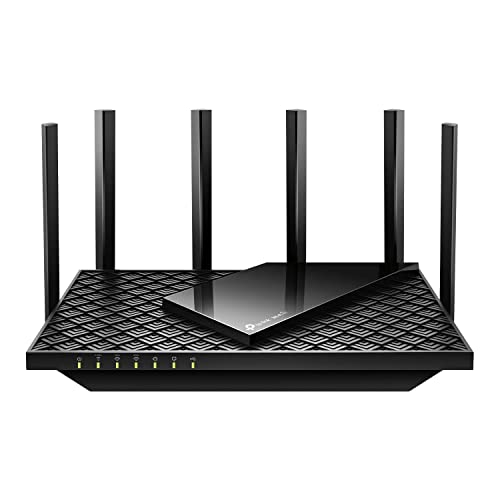
True Score
79794Experts
862kCustomers
Mixed Reviews
 SAVE $70$199.99$129.99
SAVE $70$199.99$129.99Read More
Snapshot
Reasons to Buy
- Good WiFi speeds
- Adequate range
- Simple set up
Reasons to Avoid
- Average download speeds
- Limited coverage
- Subscription-based security solutions
Specifications

# of LAN Ports 4 
Frequency Bands 2.4 GHz, 5.0 GHz, 6.0 GHz 
MU-MIMO Support Yes 
Wireless Standard AC, AX 
Mesh System Yes 
Quality of Service Prioritization Yes 
# of Phone Ports n/a 
# of WAN Ports 1 
App Compatible Yes 
Available Storage n/a 
Band Technology Tri 
Data Encryption Type WPA3 
Energy Star Certified n/a 
Integrated Modem No 
LAN Ports Gigabit Ethernet 
Number of Antennas 6 
Parental Controls Yes 
Processor Cores Triple 
Processor Speed 1.7GHz 
WiFi Range 2500 sq.ft 
WiFi Speed 2.4GHz 
Wired Speed 1000 Mb All Specs
Test Results
2.4 GHz Download speed (Mbits/s) 65 5 GHz Download speed (Mbits/s) 309 6 Ghz Download speed (Mbits/s) 318 Latency (ms) 9 Router Range (ft) 60 2.4 GHz Upload speed (Mbits/s) 0 5 GHz Upload speed (Mbits/s) 0 6 Ghz Upload speed (Mbits/s) 0 All Tests
All Retailers
- $129.99$200Save $70
- $129.99$180Save $50
- $159.00
Our Verdict
The TP-Link Archer AXE75 provides Xfinity users with an efficient and cost-effective router option, perfect for medium-sized homes. Its tri-band performance achieves a 6 GHz download speed of 317.9 Mbits/s, making it great for activities such as HD video streaming and casual gaming. This router is a good fit for remote workers and tech enthusiasts seeking a stable home network without a hefty price tag.
If your household uses multiple online devices simultaneously, the Archer AXE75’s performance across the 2.4 GHz and 5 GHz bands ensures uninterrupted connectivity. With download speeds of 65.05 Mbits/s on the 2.4 GHz band and 309.1 Mbits/s on the 5 GHz band, it efficiently manages daily internet demands, providing smooth browsing, streaming, and gaming experiences. Its coverage extends to 60 ft, is suitable for small to medium areas, and boasts an impressive latency of just 9 ms for swift online responses.
When comparing the Eero Max 7 against the TP-Link Archer, the Eero Max 7 offers faster speeds and broader coverage with its superior 6 GHz performance and range, suitable for users who want performance and can afford the premium price. The Archer AXE75 is a more budget-friendly choice that still offers reliable performance for general use and casual gaming.
Balancing affordability with solid speeds and Wi-Fi 6 benefits, the Archer AXE75 stands out as a valuable choice for Xfinity customers prioritizing cost-efficiency and reliable home internet. Although its range can only support smaller living spaces like apartments, its overall performance and advanced features make it an effective solution for maintaining strong and flexible internet access.
Read Less

Best Overall

Runner Up

Best Value

Best Budget

Best Mid-Range

Premium Pick
Eero Max 7
Best For Fiber Optic
Eero Max 7 is great for Xfinity users needing fast Wi-Fi, especially for streaming, gaming, and smart homes, with top-tier 6 GHz performance.
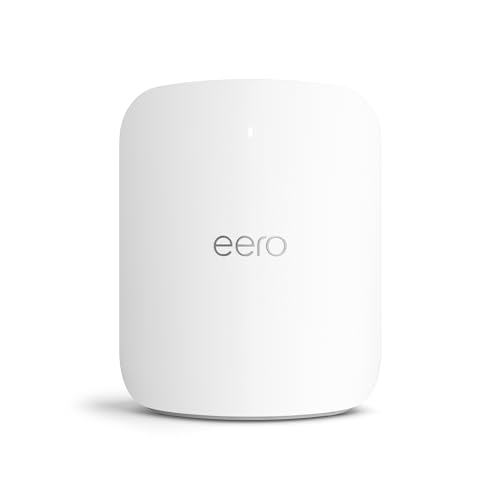
True Score
79797Experts
85317Customers
Mixed Reviews
 $599.99
$599.99Read More
Snapshot
Reasons to Buy
- Exceptional Download WiFi Speed
- Easy Installation and Configuration
- Low Latency
Reasons to Avoid
- Poor 2.4 GHz Upload Speeds
- Short Range of Coverage
- Limited Port Space
Specifications

# of LAN Ports 4 
Frequency Bands 2.4 GHz, 5.0 GHz, 6.0 GHz 
MU-MIMO Support Yes 
Wireless Standard BE 
Mesh System Yes 
Quality of Service Prioritization No 
# of Phone Ports n/a 
# of WAN Ports 1 
App Compatible Yes 
Available Storage 4000MB 
Band Technology Tri 
Data Encryption Type WPA2-Personal, WPA3-Personal 
Energy Star Certified No 
Integrated Modem No 
LAN Ports 2 Gb Ethernet 
Number of Antennas 10 
Parental Controls Yes 
Processor Cores Quad 
Processor Speed – 
WiFi Range 2500 sq.ft 
WiFi Speed 4.3 Gb 
Wired Speed 10000 Mb All Specs
Test Results
2.4 GHz Download speed (Mbits/s) 96 5 GHz Download speed (Mbits/s) 1,078 6 Ghz Download speed (Mbits/s) 1,223 Latency (ms) 7 Router Range (ft) 90 2.4 GHz Upload speed (Mbits/s) 75 5 GHz Upload speed (Mbits/s) 411 6 Ghz Upload speed (Mbits/s) 638 All Tests
All Retailers
- $599.99
- $599.99
- $599.99
Our Verdict
If you’re looking for a router with the fastest performance on the most advanced Wi-Fi band, the Eero Max 7 offers unparalleled performance. Its 6GHz band achieves download speeds of up to 1222.5 Mbits/s and upload speeds of 638 Mbits/s. Those are ideal for large homes with tech enthusiasts and competitive gamers who demand rapid connection for streaming, immersive gaming, and comprehensive smart home functionality.
The Eero Max 7 also impresses on the 5 GHz band, with download speeds reaching 1078.5 Mbits/s and upload speeds of 410.6 Mbits/s. This band offers reliable performance across a variety of online activities without signal interference. The 2.4 GHz band also supports downloads at 95.9 Mbits/s and uploads at 74.8 Mbits/s, providing solid connectivity for everyday internet tasks.
Boasting a low latency of 7 ms, this router facilitates quick response times crucial for seamless gaming and video calls. It covers an area of 90 ft, making it suited for small to medium-sized spaces. When comparing the Max 7 to the Netgear Nighthawk RAXE300, the RAXE300 also supports 6 GHz and comes at a more accessible price, but the Eero Max 7 delivers superior speed and efficiency. This makes the Max 7 the preferred choice if your digital lifestyle includes high-definition streaming, virtual reality experiences, and connectivity for numerous devices.
With unbeatable 6 GHz band speed, the Eero Max 7 meets the demands of high streaming quality, gaming performance, and heavy internet usage. Despite its premium price, the router’s outstanding performance justifies the investment if you’re an Xfinity customer looking for a top-tier, high-speed internet solution across all your devices.
Read Less
Which Criteria Matters for Testing Best Routers for Xfinity?
By focusing on these criteria (2 required, 2 nice to have), anyone can quickly and easily compare these routers and how they’ll perform. This helps you make an informed decision and purchase a router that will meet your needs.
| CRITERIA | RANGE | REQUIRED | DEFINITION |
|---|---|---|---|
| 2.4 GHz Download Speed | > 50 Mbits/s | Yes | The maximum speed that the router can reach when downloading on the 2.4 GHz band. |
| 5 GHz Download Speed | > 200 Mbits/s | Yes | The maximum speed that the router can reach when downloading on the 5 GHz band. |
| Router Range | > 50 ft | No (Nice to have) | How far a device can be from a router before the signal starts degrading. It is worth noting that 2.4 GHz reaches further than 5 GHz. |
| Latency | < 40 ms | No (Nice to have) | The delay that is created by a signal being sent by the router and then received. |
Our Trusted Data Sources
We looked at 120+ router reviewers and found that 46 are trustworthy (60%+ Trust Rating). The three we have listed below are our most trusted for routers.
- James Morris – Kit Guru, LinkedIn
- Matt Spencer – TechGearLab, LinkedIn
- Brian Nadel – Tom’s Guide, MuckRack
Interested in a comprehensive analysis of our data sources? We’ve got you covered. Below, you’ll find a detailed list of every router review website we’ve identified, organized by their respective Trust Ratings from highest to lowest. But we didn’t stop there. We’ve meticulously reviewed each publication and verified the data by checking whether the authors have bio links to MuckRack or LinkedIn. We’re committed to not only checking the facts but ensuring their veracity.
Router Test Data & Results
Disclaimer:
Evaluating router performance is more than hardware analysis. While hardware tests are straightforward, the challenge lies in contextualizing the results within the limits of real-world usage. Routers operate under conditions that testers cannot fully standardize, including variations in Internet Service Providers (ISPs), network traffic congestion, discrepancies between advertised and actual internet speeds, and the physical layout of homes. These factors introduce a degree of unpredictability, making it hard to draw universal conclusions. As such, our router recommendations aim to provide useful general guidance, accommodating a wide range of home environments and internet setups.
1. 2.4 GHz Upload Speed (Mbits/s)
Upload speed is just the reverse of download speed. Instead of pulling down info, you’re uploading it. This is common when uploading documents or photos to a website, or when you’re streaming content to a platform, like Twitch.
Generally speaking, your upload speed is going to be limited more by your ISP than by your router, because bandwidth is a two-way street when it comes to routers. Pulling 100 MBits down means you should be able to push 100 MBits up, but if your ISP throttles your upload, then it doesn’t matter if your router allows for a full gigabit up, you can only go as fast as the “speed” limit allows. It’s for that reason we set 2.4 GHz upload limits at 50 Mbits, but in reality, anything you can get is acceptable, since this band isn’t – and shouldn’t – be used for anything that requires real speed.
2.4 GHz Upload Speed
> 50 Mbits/s
Acceptable range of performance
Definition: The top speed the router reaches uploading on the 2.4 GHz band.
Units of Measurement: Mbits/s (megabits per second)
Tools to Measure: Speed-checking software
Why It’s Important:
For older devices or for connecting at a longer range, the 2.4 GHz frequency is the only one that you’ll be able to use, so it should have usable speed.
2.4 GHz Upload Speed (Mbits/s; higher is better; 0 = No Data)
2. 5 GHz Download Speed (Mbits/s)
5 GHz Download Speed
> 200 Mbits/s
Acceptable range of performance
Definition: The top speed the router reaches downloading on the 5 GHz band.
Units of Measurement: Mbits/s (megabits per second)
Tools to Measure: Speed-checking software
Why It’s Important:
This band is used by most modern devices and offers greater speeds that enable activities like gaming and HD streaming on multiple devices.
The much faster 5 GHz band offers up much greater bandwidth and is much, much better at meeting high-speed demands. Streaming high-quality video, using streaming services, gaming, downloading large files and games – the 5 GHz band is what makes all of these activities quick and bearable. It reaches a lower range than the 2.4 GHz band, but it’s also much faster, so you’ll use it more, especially on newer devices that actually support the band.
Given how much you’ll be using this band, we recommend a speed of at least 200 Mbits/s to ensure you’re able to enjoy streaming and gaming on at least a few devices simultaneously. Any lower and you start to run into real bottleneck concerns, such as endless buffering, lagging, or drops in connection.
5 GHz Download Speed (Mbits/s; higher is better; 0 = No Data)
3. Router Range (ft)
Router range is exactly what the name suggests: how far can you get from the router before you start experiencing issues with your connection? The complicating factor is the simple fact that range depends on the band you’re using. 2.4 GHz is a band that offers greater range, so it gives tests results that show a greater range than tests that use the 5 GHz band. In general, our research found most publications used the 5 GHz band, so our recommendations are based on that.
As such, we recommend your router have a range of at least 50 ft. This gives you a good “bubble” around the router that you can connect to, but it’s important to know that things like the walls in your home can cause issues. Thicker walls block more signal, thinner walls block less. Some materials will also do a better job than others will at stopping signal, so if you see a router with a range of 65 ft, know that it might not reach that far in your home. It could reach further – or not nearly as far. This is also why you get dead zones in your home – it’s a matter of geometry and materials.
Router Range
> 50 ft
Acceptable range of performance
Definition: The distance the router transmits reliable signal out to before performance and speed degrades.
Units of Measurement: Feet (ft)
Tools to Measure: Measuring Tape
Why It’s Important:
Range impacts how far you’ll get a reliable connection in your home, and whether you’ll need extenders or not.
Router Range (ft; higher is better; 0 = No Data)
4. Latency (ms)
Latency
< 30 ms
Acceptable range of performance
Definition: The time it takes for the router to send and then receive signals.
Units of Measurement: Milliseconds (ms)
Tools to Measure: Speed-checking software
Why It’s Important:
Latency is important to reduce delay when gaming and video conferencing.
On a router, latency refers to how long it takes for the router to send out and receive a signal. The longer it takes, the more delay there is between you sending and receiving data, which can introduce lag in video games and also makes video conferencing harder since the person you’re speaking with now has to contend with your delay and vice versa. If you’ve ever spent a call talking over someone because you don’t know they started talking a second ago, that’s latency.
For that reason, we recommend a latency below 30 ms. As low as you can get it is obviously preferable, but latency is another aspect of your internet connection that is hard to manage. Latency differs to every single place you connect to, and every ISP has its own latency they “add” because you have to connect to their service too. Latency creeps in from your ISP, from the site you’re requesting data from, from your router, and from your own onboard Wi-Fi antenna – and that’s just to name a few sources. If you’re gaming, you also have a delay introduced by your connection to game servers and the delay that exists on a hardware level when you input commands.
Latency (ms; lower is better; 0 = No Data)
Best Routers for Xfinity: Mistakes To Avoid
- Ignoring Compatibility: Not all routers are compatible with Xfinity services. Make sure the router you choose supports Xfinity’s specifications, including DOCSIS standards for cable internet or compatibility with Xfinity’s fiber-optic services.
- Overlooking Speed Requirements: Consider the speed tier of your Xfinity plan and ensure the router you select can handle it. Opting for a router with lower capabilities than your plan may result in slower internet speeds and diminished performance.
- Neglecting Dual-Band or Tri-Band Support: Xfinity networks operate on both 2.4GHz and 5GHz frequencies. Dual-band or tri-band routers allow for better distribution of devices and traffic, reducing congestion and improving overall performance.
- Ignoring Coverage Needs: Assess the size of your home or office space and choose a router with adequate coverage. Factors such as building materials and layout can affect Wi-Fi range. Mesh systems or routers with strong antennas may be necessary for larger areas.
The Best Routers for Xfinity Tests Compared
Product |
True Score
|
2.4 GHz D/L Speed
|
5 Ghz D/L Speed
|
6 GHz D/L Speed
|
Range
|
Latency
| |
|---|---|---|---|---|---|---|---|
| 83 |
|
|
|
|
| $99.99 $250 $150 |
| 83 |
|
|
|
|
| $164.99 $300 $135 |
| 80 |
|
|
|
|
| $456.99 |
| 79 |
|
|
|
|
| $129.99 $200 $70 |
| 79 |
|
|
|
|
| $599.99 |

